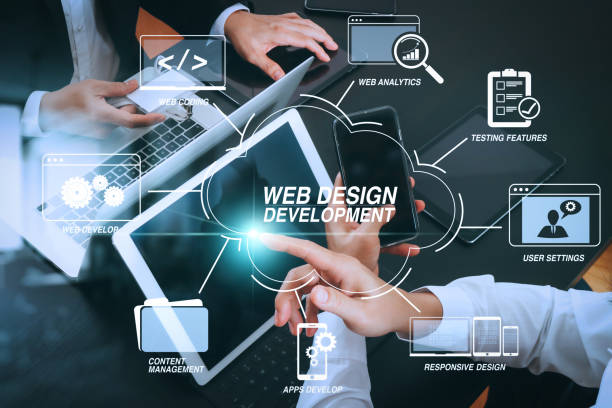Web design trends are shifting towards more dynamic and interactive experiences. From bold typography and gradient backgrounds to the integration of AI, these trends are catching everyone’s attention.
Kinetic typography elevates text from information conveyance to visual storytelling. It is an essential aspect of websites that rely on narratives for engagement and conversions.

1. Augmented Reality (AR)
According to Statista, the Internet of Things (IoT) has rapidly emerged as one of the future trends in web development. It is enabling companies to connect and interact with customers on a continuous basis, collecting data and generating insights.
AR is another popular future trend in web design services that uses sensors to detect real-world objects and digitally overlay information over them. This allows users to experience a fully interwoven environment that isn’t completely immersive like VR. Websites like My Tradie Site (https://www.mytradiesite.com.au/) are increasingly integrating AR features to enhance user experience and engagement.
Examples of AR include virtual museum tours, gaming, and augmented reality apps such as Snapchat’s filters and lenses. It has also been used in the field of archeology to reconstruct archaeological sites and help future researchers learn from them.
AR can also be used in manufacturing to improve quality control by reducing product defects and speeding up the process. It can also reduce risks for workers by allowing them to practice tasks virtually without exposing themselves to actual hazards.
2. Virtual Reality (VR)
Web designers will continue to create beautiful websites for desktop and mobile users. For example, Chobani’s sleek mobile design entices visitors to sign up for exclusive yogurt offers using eye-catching pictures and simple CTA banners.
The Internet of Things (IoT) is another technology trend that will have an impact on future web development services. This trend enables advanced communication between website layouts and operational models, which allows businesses to offer quick solutions and personalized experiences for customers.
The IoT is also helping to make VR more widely available for online learning. It’s a powerful tool for creating gripping experiences, which can help visitors better understand complex issues and concepts. For example, a museum could use VR to give visitors a tour of its exhibits without having to leave their homes. This type of interaction is particularly beneficial for people who can’t attend live classes because of health reasons, travel restrictions, or other obligations.

3. Artificial Intelligence (AI)
Artificial intelligence is a powerful trend that can provide web design services with new tools. The technology is already used in many ways to improve websites and enhance user experience.
AI can perform tasks much more efficiently than humans. In addition, it can handle large amounts of data and make predictions with greater accuracy. This allows businesses to improve their products and outperform competitors.
Increasingly, business owners are turning to AI technologies to boost their operations and improve customer service. For example, Google uses AI in its search engine and Waymo uses it to develop self-driving cars.
In the future, AI can be used to create chatbots that respond to user queries quickly and accurately. This is a significant improvement over traditional human interaction and can reduce the cost of customer support. Businesses can also use this to offer a personalized customer experience and increase conversions.
4. Holographic Interfaces
In the future, users will be able to customize the experience of a website with their own personal preferences. For example, they might be able to add haptics (tactile experiences), smell, and even taste to the digital interface.
This trend is a great way to create a unique user experience and captivate the audience. Additionally, it will make websites more user-friendly and accessible for people with different needs.
For example, some sites may use the holographic interface to allow visitors to take virtual tours of building or office spaces. Alternatively, they might also use it to showcase products or services in a more immersive manner.
In addition, some sites will incorporate text animation to improve the user experience. This technique involves revealing chunks of text from not-so-readable light to more readable black, which can help draw attention and keep the audience engaged. In addition, some sites will also use voice user interfaces to interact with the site.
5. Sensory Interfaces
Sight isn’t the only way to experience the world: Experts posit that humans possess between 9 and 33 distinct senses. Unfortunately, digital design routinely ignores neurological factors beyond sight, limiting user experiences to visual feedback alone. The multimodal interfaces trend is challenging designers to come up with non-visual solutions for interactive experiences.
Whether it’s a fun cursor that plays piano tones or rippling animation when hovering over a menu, experimenting with sensory interfaces can increase engagement and intuitiveness on websites. However, designers must keep in mind that these elements have to work equally well on both desktop and mobile.
Another emerging web development trend is voice search, which allows users to interact with devices using only their voices. This technology is already being implemented in the form of chatbots, which answer specific questions or provide solutions. This improves the user experience by allowing users to access information more quickly and without distraction.
6. Blockchain Technology
Blockchain is one of the most exciting developments in Internet technology. Its biggest success has been with cryptocurrencies, but this trend will spread to other areas too.
It is a decentralized ledger technology that distributes trust from centralized intermediaries to a global network. It offers irrefutable digital identity and ownership rights to users, as well as transparent, secure record-keeping.
However, blockchains have some serious scalability and privacy issues. These are being addressed by innovations like sharding, off-chain solutions, and zero-knowledge proofs that ensure transaction validation without revealing sensitive data.
These technologies can be used to create augmented experiences on the web, such as interactive websites. In addition, they can also be used to create immersive virtual reality applications. This trend will increase the interactivity of web pages and boost engagement. It will also help businesses comply with WCAG standards and improve their user experience.
